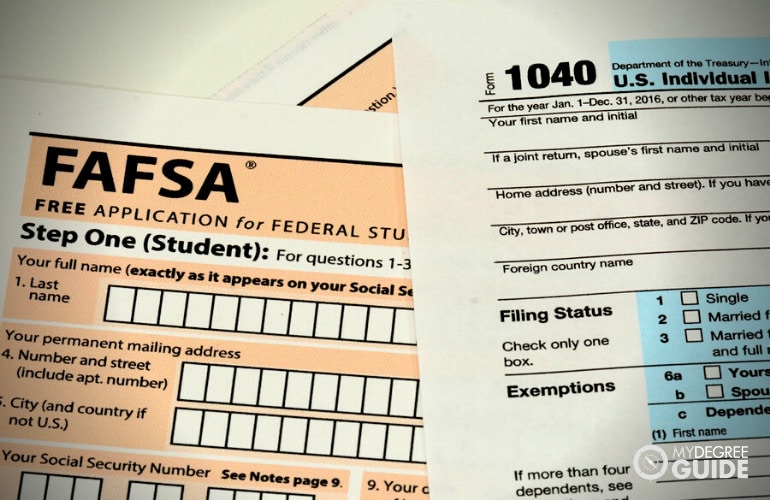Some of the best transfer schools can help you achieve your educational goals while offering you the best fit possible in terms of educational quality, extracurricular offerings, financial costs, and learning options.

Schools with some of the highest college acceptance rate for transfer students may offer you the right learning environment to complete your degree and break into the field of your choice.
Editorial Listing ShortCode:
While community college transfer rates can vary from school to school, there are a number of promising options available.
Best Colleges for Transfer Students

Students may choose to transfer colleges for a number of different reasons, such as:
- Personal fit
- Professional goals
- Financial needs
- Location requirements
In some cases, students may decide to transfer schools if the program they’re currently enrolled in isn’t the best match for their educational goals. For instance, you might like that a different program offers internship or work placement opportunities.
Editorial Listing ShortCode:
Students might also choose to transfer to benefit from part-time versus full-time enrollment options or online versus on-campus study options. There are a number of reasons that you may choose to transfer schools. There are also different factors that can impact your ability to be accepted into a new school and to transfer existing credits.
Transfer Student Acceptance Rate

According to the National Association of College Admission Counseling, the transfer student acceptance rate is 62%. The rate of admission for non-transfer, or freshman, students is slightly higher at 66%.
In order to make the most of your efforts to transfer into another school, it may be worth your while to look into the colleges that accept the most transfer students.
Transfer Credits
The number of credits that you may be able to transfer into your new school and program can vary greatly depending on a number of factors. For example, the compatibility of each program and the accreditation status of the program in which your credits were completed can affect their transferability.
How to Increase Your Transfer Acceptance Chances

If you’re keen on attending a school that happens to have a low acceptance rate for transfer students, here are a few things you can do to help your application stand out:
- Research the transfer process. Take some time to understand the transfer process, the application requirements, and the acceptance rates for different schools that you may be interested in transferring to.
- Connect with an academic advisor. Academic advisors can often help you get a better understanding of which credits you may be able to transfer into a new program.
- Gather all required documents. When applying as a transfer student, it’s still important to have all the required documentation and information needed for your application. This typically includes transcripts from all completed postsecondary courses, even the ones you may not be planning on transferring.
- Look for articulation agreements. Finding a school that has an articulation agreement with your existing school may help simplify the entire process and improve your chances of acceptance.
- Pay attention to your grades. If you know you’re going to transfer to another school later on, you may want to pay extra attention to the grades you’re earning in the courses you’re wanting to transfer. For transfer students, your postsecondary GPA and course grades are more important than your high school scores, so they can play an important part in whether you’re accepted as a transfer student into another school.
- Admission essay. Some schools require an admission essay as part of your application package. An admission essay could be an opportunity for you to address common concerns that schools have when it comes to transfer students. You can also explain why you’re a good candidate for their programming.
Another way you can try to increase your transfer acceptance chances is to apply to schools that have higher transfer acceptance rates. Looking at schools that specifically recruit transfer students and have a higher number of transfer slots available can help increase your overall chances of acceptance.
How to Transfer Colleges

Understanding how to transfer colleges and move from one school to another can seem like a daunting process for any student. Whether you’re transferring from a community college to a 4 year university, switching colleges, or transferring as a member of the military, here are some common steps in the transfer process:
- Evaluate if transferring is the best option for you. This can include comparing program offerings, understanding tuition costs, and discovering whether part-time or full-time and online or on-campus attendance options are available.
- Seek support of an academic advisor or counselor. Professional advisors can provide you with valuable insight into the transfer process. They may help you discover your chances of acceptance into another program and which completed course credits may be eligible to transfer into the new program.
- Check your prospective school’s accreditation status. The accreditation status of a school is an important factor to consider. Not only can a school’s accreditation status influence your ability to enroll in graduate programs down the road, but it can also impact hiring decisions by potential employers.
- Gather the required documents. Once you have settled on the school and subsequent program you’re interested in transferring to, you’ll gather all the documents that are required as part of that school’s admissions process.
- Connect with the admissions office at your prospective school. This is a good time to get more information on the specific school’s credit transfer policies. This can give you a more concrete idea of what credits you’ll likely be able to transfer into the program.
- Evaluate your options. Once you have an idea of how many credits you’re able to transfer into the new program, you can weigh the pros and cons in order to make a final decision on whether transferring is the right path forward for you.
Once you’ve done all the leg work and have decided on the school you’re interested in transferring to, you can complete and submit your application to the school of your choosing.
Tips for Transfer Students

When it comes to transferring to a new school, the process can appear overwhelming. There are a number of things that you can do, though, to help ease the process. First and foremost, before transferring to a new school, it is important to make sure that transferring to a new school is the right decision for you.
Some important considerations when deciding whether to transfer can include:
- Costs. Look at the financial costs of your existing school versus another school.
- Program options. Compare program coursework and offerings, such as internship opportunities, at different schools.
- Attendance options. Decide between part-time, full-time, online, and on-campus options offered by various schools.
- Location. Some schools have different tuition costs for in-state and out-of-state students.
Once you’ve decided to transfer, it’s strategic to gain a solid understanding of what the transfer process looks like and to organize your documents and necessary paperwork. This can help the process go as smoothly as possible.
Editorial Listing ShortCode:
Transferring schools may also take a toll financially, particularly in relation to federal aid. So, it’s helpful to be aware of how your transfer may impact your financial aid package and what steps you may need to complete in order to keep your funding in place.
Admissions Requirements for Transfer Students

Admissions requirements can vary from one school to the next. In some cases, transfer students may need to submit additional items when compared to first-time applicants or freshman students. Common admissions criteria for transfer students can include:
- High school diploma
- Transcripts from all postsecondary studies
- Minimum GPA from your postsecondary studies
- Letters of recommendation
- SAT or ACT scores (only some schools require them)
When submitting letters of recommendation as a transfer student, it may be more valuable to have those letters come from postsecondary advisors or professors. Only some schools request recommendations for admissions. The specific admissions criteria can vary depending on the school you choose to apply to as a transfer student.
Is Accreditation Important When Transferring?

Yes, accreditation is an important consideration when transferring. Completing your degree at an accredited school may impact your ability to enroll in masters or PhD programs later on and may influence the hiring decisions of potential employers.
In addition, if you’re wanting to transfer credits into your new program, whether or not the credits were obtained from an accredited institution can impact their transferability. The US Department of Education’s website offers information on the accreditation status of various schools across the country.
Does Transferring Affect Financial Aid?

Pursuing college transfer programs can be a great way to make sure your postsecondary education is the best fit for you. Making the decision to transfer, though, can impact your financial aid.
If you’re funding your education through federal financial aid programs, you’ll likely need to update your Free Application for Federal Student Aid (FAFSA). By transferring schools, your total funding amount may change, depending on the cost of your new program and how it compares to your previous program.
Additionally, transferring to a new school may trigger the payback timeline on your existing student loans to start. It’s common for federal financial aid repayment to be required 6 months after wrapping up at the school for which the aid was originally approved for.
Should I Transfer Colleges?

The decision to transfer colleges is a very personal one, but here are some factors that may influence your want or need to take advantage of some of the best transfer colleges:
- Wanting to be closer to home
- Finding a program that better fits your professional goals
- Finding a school that has different extracurriculars
- Needing to attend a school with lower costs
Before making the decision to transfer colleges, you may want to look into transfer friendly colleges or colleges that accept all transfer credits so you can get the most bang for your buck.
Is Transferring Colleges Hard?

While the college transfer experience may be different for each student, there are some common hurdles that exist, such as the rate of admission for transfer students.
Your ability to transfer to another school can be influenced by factors like your overall GPA, the accreditation status of the school where you earned your credits, and how your existing transfer credit options fit with your new program.
Editorial Listing ShortCode:
In some cases, obtaining an associate degree prior to applying as a transfer student can help your chances of being accepted into your program of choice.
What Is Transfer Rate?

Transfer rate is the rate at which transfer students are accepted or admitted into programs at a postsecondary school.
According to the National Association of College Admission Counseling, the overall transfer rate for admission is 62%, and the non-transfer admission rate for freshman students is 66%. Notably, the transfer rate can vary significantly from one school to the next.
In some cases, certain schools only accept a very limited number of transfer students each year. This may be impacted by the number of freshman students that leave during their first year of postsecondary education.
Will My Credits Transfer?

Even when you’re looking at some of the easiest colleges to transfer into, the first step in transferring or considering a transfer is to speak with an academic advisor. They can help you discover whether your credits will transfer into a specific program.
It can also be helpful to find out whether your existing school has articulation agreements with other schools. This can help simplify the transfer process and make sure you transfer the most credits possible.
What Are the Best Schools to Transfer To?
Some of the best schools to transfer to are those with high graduation rates for transfer students. Here are some of the top schools to transfer to according to Money.com:
- University of California – Los Angeles
- University of California – Berkeley
- Emory University
- California State University – Channel Islands
- California State University – Long Beach
- University of California – San Diego
Other top transfer schools mentioned by Money.com include the University of California – Santa Barbara, San Diego State University, and the University of Florida.
What Colleges Accept the Most Transfer Students?
You may be interested in transferring schools to find a better fit for your personal interests, your professional goals, or your budget. Regardless of your reasons, there are a number of school options available that have some of the highest college transfer acceptance rates.
Editorial Listing ShortCode:
According to US News, the colleges that accept the most transfer students include:
- University of Maryland
- Florida International University
- University of Central Florida
- California State University
- University of Texas
- Liberty University
Other schools that have high acceptance rates for transfer students include the University of Houston, San Jose State University, and Pensacola State College.
What Are the Easiest Schools to Transfer To?

Schools with high transfer acceptance rates are often some of the easiest to transfer to. According to CBS News, some of the easiest schools to transfer to include:
- The Academy of Art University
- American Samoa Community College
- Boston Architectural College
- Broward College
- Cameron University
Other schools with high transfer acceptance rates include Dickinson State University, Dixie State University, Feather River College, and Glenville State College. Choosing a school with a higher acceptance rate for transfer students can help make it easier to transfer your credits and enroll in the program of your choice.
Universities Accepting More Than 60 Transfer Credits
Methodology: The following school list is in alphabetical order. To be included, a college or university must be regionally accredited, offer degree programs online or in a hybrid format, and accepted more than 60 transfer credits.

Arizona State University allows students to transfer qualifying credits from previous college-level courses completed with a grade of C or higher. While an unlimited number of qualifying credits from 4 year institutions can be transferred into a program, only 64 semester hours can be transferred from community, junior, or 2 year colleges.
Arizona State University is accredited by the Higher Learning Commission of the North Central Association of Colleges and Schools.

Champlain College allows students to transfer up to 90 qualifying credits towards a bachelor’s degree.
Available transfer credits will be determined by the school when applying. Additional credits may be transferred into the program after admission by talking with academic advisors. Credits may be received for prior education, professional training, national tests, or military training.
Champlain College is accredited by the New England Commission of Higher Education.

Colorado Technical University offers several ways for students to transfer credits, including qualifying past courses, life experiences, work experiences, and military training. At least a quarter of a person’s credits must be completed at the school. Students may also complete exams to prove expertise in subjects to earn credits.
Colorado Technical University is accredited by the Higher Learning Commission.

Drexel University completes a Transfer Credit Evaluation after a student has been accepted to determine what credits a student may transfer. For a credit to be considered, a grade of C or higher must have been obtained. Up to 60 qualifying credits can be transferred into a program.
Drexel University is accredited by the Middle States Commission on Higher Education.

Franklin University allows students to transfer in up to 94 qualifying credits from a community or technical college. Students may also obtain credits from military training, professional training, tests, and a portfolio. Additionally, up to 24 qualifying vocational or technical credits may be transferred into Franklin’s Degree-Completion Majors.
Franklin University is accredited by the Higher Learning Commission.

Transfer students at George Mason University may have their credits evaluated a week after being accepted into the school. Up to 90 qualifying credits can be transferred in, however only 75 credits may come from a community college. For a credit to be eligible for transfer, a grade of C or higher must have been obtained.
George Mason University is accredited by the Southern Association of Colleges and Schools Commission on Colleges.

Grand Canyon University offers transfer students a transfer credit evaluation. Students may submit their community college transcripts and talk to one of the school’s transfer specialists to determine which credits are eligible. Up to 90 qualifying credits may be transferred into a program. Only 30 credits can come from a military school.
Grand Canyon University is accredited by the Higher Learning Commission.

King University allows students to transfer up to 76 qualifying credits into a program. Some programs may not allow transfer credits due to the potential for information to become outdated quickly. A grade of C- or higher must have been obtained for a course to be considered for transfer.
King University is accredited by the Southern Association of Colleges and Schools Commission on Colleges.

Liberty University allows students pursuing a bachelor’s degree to transfer in up to 90 qualifying credits. Students may be able to transfer credits from previous classes or credit exams. They may also be able to gain credits by proving expertise in an area, from military training, or by creating a portfolio to prove professional experience in the field.
Liberty University is accredited by the Southern Association of Colleges and Schools Commission on Colleges.

Loyola University—Chicago allows students to transfer in qualifying credits. After being admitted, transfer students receive an email report dictating which courses are accepted for transfer. Classes that were completed with a grade of C- or lower cannot be transferred in to cover a major requirement.
Loyola University – Chicago is accredited by the Higher Learning Commission.

Malone University allows students with a minimum of 30 credits and an overall GPA of 2.0 to transfer into their online programs. A maximum of 90 qualifying credits can be transferred into the school. Students must submit official transcripts from all post-secondary institutions they’ve attended.
Malone University is accredited by the Higher Learning Commission.

Purdue University allows students with qualifying credits to transfer up to 75% of required credits into a program.
Students must submit transcripts from all previously attended institutions to the office of registration for their credits to be reviewed. Up to 135 credits may be obtained from military training. A portfolio may be submitted to gain credits for qualifying work experience.
Purdue University is accredited by The Higher Learning Commission of the North Central Association of Colleges and Schools.

Regent University allows students to transfer up to 90 qualifying credits towards a bachelor’s degree. Credits may be obtained from past courses, the completion of entrance level examinations, training programs, and military training. To transfer credits, students must complete a PLA Self-Assessment and submit a portfolio.
Regent University is accredited by the Southern Association of Colleges and Schools Commission on Colleges.

Southern New Hampshire University allows students to transfer in up to 90 qualifying credits from previously attended post-secondary institutions.
Official credit evaluations are conducted to determine which credits are eligible for transfer. Credits may also be earned from qualifying work or life experience if the student has received training or certification.
Southern New Hampshire University is accredited by the New England Commission of Higher Education.

The University of Central Florida allows undergraduate students to transfer into their programs. Different admission requirements are available for students transferring in with less than 30 credits, 30 to 59 credits, and 60 or higher credits. Students are provided with a transfer credit report after being accepted into the school.
The University of Central Florida is accredited by the Southern Association of Colleges and Schools Commission on Colleges.

The University of Houston allows students to transfer in qualifying credits from previously attended institutions. The credits may only come from courses that were finished with a grade of C- or higher. Students must complete 30 semester credit hours at the school and may only transfer 66 credits from lower-division courses.
The University of Houston is accredited by the Southern Association of Colleges and Schools Commission on Colleges.

The University of Illinois—Springfield allows undergraduate students to transfer into their programs.
To be considered a transfer student, students must have at least 30 qualifying credits to transfer into a program. A maximum of 72 lower-division credits and 30 upper-level credits may be transferred. At least 30 credits must be completed at the school.
UIS is accredited by the Higher Learning Commission.

The University of Maryland Global Campus allows students to transfer qualifying credits from previous institutions.
While a maximum of 60 credits may be transferred in from a program that lasted 2 years, 90 credits may be transferred from a 4 year program. Official transcripts from all previously attended institutions must be submitted to the school by the student.
UMGC is accredited by the Middle States Commission on Higher Education.

Walden University allows students to transfer qualifying credits from previous courses or certifications.
Official transcripts need to be submitted when applying. Students accepted into a program receive a Transfer-of-Credit Evaluation that may be reviewed by an enrollment specialist. Only credits with a grade of C or higher are eligible to be transferred.
Walden is accredited by The Higher Learning Commission.

Western Governors University offers an Onward With Learning (OWL) transfer program.
The program is designed for community college students who require at least 2 more semesters to graduate. OWL’s goal is to help students complete their associate degree, enter into a specific bachelor’s program, and graduate in a timely manner. Students in this program only have to complete 60 credits to earn a bachelor’s degree.
Western Governors University is accredited by the Northwest Commission on Colleges and Universities.
Transferring to an Online College

Transferring to another college may seem like a daunting task, but there are a number of accredited schools with high acceptance rates for transfer students. There are also schools with higher graduation rates for transfer students.
These transfer-friendly schools can help make the process a little less overwhelming. While transferring to a new school can impact your financial aid qualifications, it can also help you move to a college that is a better fit for your personal preferences and professional goals.
By comparing the tuition costs, educational program offerings, and extracurricular options of various schools, you may be able to find the right fit for you.

